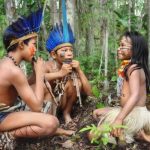Estimates may vary, but it is commonly accepted that between 50% and 90% of the world’s ~7,000 languages will disappear by the end of the 21st century without substantial preservation efforts. Many of these languages do not have a written form. On average, a language dies or goes extinct every two weeks when its last speaker dies. The death of a language means the death of a culture. Thousands of years of history, stories and heritage would be lost to all future generations and major pieces of the human portrait would be wiped from the face of the Earth, never to be seen again.
Minority languages are being increasingly replaced by various politically, economically, or socio-culturally dominant ones. Every two weeks, the last fluent speaker of a language passes on and along with him/her hundreds of generations of traditional knowledge encoded in these ancestral tongues. Nearly half of the world’s languages are likely to vanish in the next 100 years. Out of the all languages that exist on the planet, half of them are at risk of disappearing during this century. And out of the 7,000 languages that could disappear, the majority does not have written documents or dictionaries that would allow us to preserve these languages and to safeguard their memory. As a consequence, when the last speaker dies, we lose their language and its knowledge forever.
Co-occurrence of linguistic diversity and biological diversity
Maintaining indigenous languages and conserving biodiversity go hand in hand. While it is widely acknowledged that the degradation of the natural environment, in particular traditional habitats, entails a loss of cultural and linguistic diversity, new studies suggest that language loss has, in turn, a negative impact on biodiversity conservation.
There is however a glimmer of hope for some of these languages. Several organizations are dedicated to the documentation and potential revitalization of endangered languages.
The Enduring Voices project is a collaborative effort between National Geographic and the Living Tongues Institute for Endangered Languages. This project seeks to preserve these languages through awareness, preservation and the renewal of interest among the younger groups within the communities most at risk.The mission of the Living Tongues Institute for Endangered Languages is to promote the documentation, maintenance, preservation, and revitalization of endangered languages worldwide through linguist-aided, community-driven multi-media language documentation projects.
Projects begin with expeditions to communities to dialogue with the last speakers of endangered languages worldwide. After they obtain the permission of the community to work with them, they discuss various courses of action to help them meet their own goals of maintenance, revitalization, program. Storybooks, basic literacy materials as well as grammatical and lexical materials in electronic and print form may be produced. They publish their scientific work in leading journals and in books and archive their video for the use of future generations.
The Digital Encyclopedia of Languages
Sorosoro has the ambition to progressively set up the Digital language Encyclopedia – the first facet of the program.
The researchers, linguists and anthropologists are doing tremendous work and have succeeded in the safeguard of many languages that would have disappeared form the human memory if this detailed literary work had not been done. Sorosoro’s objective is to complement their work with filmed data.
Academic initiatives
Variety within variety: The linguistic landscape of Corfu
Maria Giakoumelou and Dimitris Papazachariou of the Freie Universität Berlin started investigating the dialectal situation and geographical variation in the island of Corfu (Greece) within the framework of Perceptual Dialectology. More specifically, their aim is twofold a) to report on the perceptions of the Corfiots about the linguistic situation in the island and about the number of different varieties they recognize within this specific region, identifying the criteria they employ for their categorization, and b) to describe the effect of the attitudes towards the social identity of speakers of a different variety on their understanding of the difference among varieties.
The linguistic landscape of Corfu is almost completely unexplored, since the dialect spoken in the island has never been systematically investigated. A few amateur and sporadic studies (see, for example, Salvanos 1918, Laskari 1998), mainly concerning the history and the society of the island, imply that the dialect is divided into two major varieties; the variety spoken in the city of Corfu, which was heavily influenced by the Italian variety of Veneto because of the longtime occupation of the island by the Venetians, and the variety spoken in the rural areas, which remained “pure” and unaffected by foreign influences due to geographic and socio-political facts.
In order to check if the above distinction reflects the locals’ beliefs and attitudes about their own and others’ dialect areas of a region, they follow three techniques, which are of both of a qualitative and a quantitative nature: a) conversational evidence, b) questionnaires about attitudes, c) a «Draw-a-map» task (see Preston 1999: xxxiv, Niedzielski & Preston 2003).
The results confirm the lack of homogeneity inside the dialect; however, they present a greater variability than it has been presented by the previously mentioned studies, as, according to Corfiots’ judgments, there are four different varieties spoken in the island: the variety spoken in the villages of North Corfu, the variety of the villages of Middle Corfu, the Corfiot of the city, and the variety spoken in the villages of South Corfu. The differences of the varieties that lead to this categorization are identified on the phonological level (and more specifically on intonation) and on the vocabulary (the Corfiots claim that they can immediately detect a speaker’s exact origin, based on his different “singing talk”). Furthermore, it is shown that the South Corfiot is perceived by the speakers of the other varieties as more different, reflecting their general attitude towards the people of the South, who are characterized as “autonomists”, “people with a different culture, lifestyle, idiosyncrasy, even different looks”.
For more information on endangered languages see:
http://www.endangeredlanguages.com
For an overview of our medical & life sciences translation expertise, visit our translation service page.




